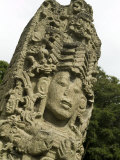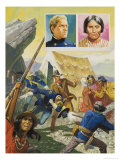|
|
|
|
|
|
|
|
|
|
|
|
BOOKS ABOUT NATIVE AMERICAN CHIEFS
|
|
|
|
|
|
|
|
|
|
|
|
|
|
|
|
|
|
|
|
|
|
 |
|
|
|
|
|
|
Keokuk
b. c. 1767
d. 1848 in Kansas; buried in Keokuk, Iowa
Keokuk, the namesake of Keokuk, Iowa, was noted for his policy of cooperation with the U.S. government. Chief Keokuk, who had not opposed the advance of the white men and voluntarily moved west of the Mississippi River from present day Illinois, was then removed again to a reservation in Kansas, although a four hundred square mile strip surrounding his village was exempted from the 1832 Black Hawk Purchase. Keokuk's position was in conflict with Black Hawk who led part of their band into the Black Hawk War.
|
|
|
|
Uaxaclajuun Ub'aah K'awiil, also known as King 18-Rabbit, was a ruler at the Mayan Copan site in present day Honduras. Little is known of 18 Rabbit other than he was beheaded c. 738 AD.
A stele is the archeological term for a “stone or wooden slab erected for funerals or commemorative purposes, most usually decorated with the names and titles of the deceased or living...”.
|
|
|
|
Kintpuash, also known as Captain Jack, was a Modoc leader who held off the US Army from a natural fortress, now known as Captain Jack's Stronghold in the Lava Beds National Monument, in January 1873.
The US had earlier moved the Modoc from their traditional lands near Lake Tule to the Klamath Reservation in Oregon. The poor conditions on the reservation forced the Modoc to return to their lands and into armed conflict. Eventually Kintpuash was executed for the death of General Canby who had broken an agreement with the Modoc.
• Kintpuash
|
|
|
|
Susan LaFlesche Picotte
b. 6-17-1865; Omaha Reservation, NE
d. 2-17-1932
Susan La Flesche Picotte was the first American Indian woman to become a physician in the US. She cared for both Indian and white patients, opening a hospital on the reservation in 1913. Her sister Susette LaFlesche was an artist and writer, their brother Francis was an anthropologist.
|
|
|
|

(no commercially available poster)
|
Edmonia Lewis
b. ca. 7-4-1845; Albany, NY
d. c. 1909-1911; Rome, Italy or Marin Co. CA
Sculptor Edmonia Lewis was born to a Chippewa mother and an African father, who named her "Wildfire." She grew up with her mother's family in Albany, New York, and spent her childhood "fishing and swimming and making moccasins." In the fall of 1859 she was admitted to Oberlin College, and she later studied sculpting privately with Edmund Brackett. Lewis became known through the bust of such famous men as Abraham Lincoln, John Brown and Henry Wadsworth Longfellow. Her statue The Death of Cleopatra received much critical acclaim; it weighted two tons and took four years to complete. Her most popular work is Forever Free, which shows an African-American man and woman at the moment of their freedom, removing their shackles. [women artists]
• Child of the Fire: Mary Edmonia Lewis and the Problem of Art History's Black and Indian Subject
|
|
|
|
Little Turtle
b. c. 1747
d. 7-14-1812
Little Turtle, a war chief of the Miami tribe in present day Indiana, was one of the most successful Native Americans in leading his followers in several victories over the United States in the 1790s. He was an advocate for peace with the U.S. in the years leading up to the War of 1812.
|
|
|
|
|
previous page | top | next
List Notable Native Americans > a | b | c | d-e-f-g | h-i-j | K-L | m | n-o-p-q | r | s | t-v-w-x-y-z
|
|
I have searched the web for visual, text, and manipulative curriculum support materials - teaching posters, art prints, maps, charts, calendars, books and educational toys featuring famous people, places and events - to help teachers optimize their valuable time and budget.
Browsing the subject areas at NetPosterWorks.com is a learning experience where educators can plan context rich environments while comparing prices, special discounts, framing options and shipping from educational resources.
Thank you for starting your search for inspirational, motivational, and educational posters and learning materials at NetPosterWorks.com. If you need help please contact us.
|
|
|
|





















